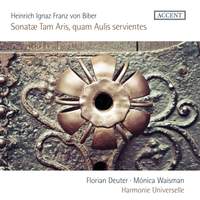Interview,
Florian Deuter on Biber's sonatas "for altar and court"
 Heinrich Ignaz Franz Biber is today famous primarily for his Rosary Sonatas - and for good reason, given their virtuosic intensity and their enduring popularity among violinists. It would be a shame, though, to let them overshadow his other works, and so February's album from Harmonie Universelle, focusing on some of his ensemble works written for the Salzburg court, was particularly welcome.
Heinrich Ignaz Franz Biber is today famous primarily for his Rosary Sonatas - and for good reason, given their virtuosic intensity and their enduring popularity among violinists. It would be a shame, though, to let them overshadow his other works, and so February's album from Harmonie Universelle, focusing on some of his ensemble works written for the Salzburg court, was particularly welcome.
The Latin title of the set of sonatas they perform translates roughly as "sonatas to be used both at the altars and in the banquet halls" - intended to be equally suitable for liturgical or social settings - and they're interspersed with Biber's twelve duos for trumpets, likely used as fanfares during formal meals. I spoke to violinist Florian Deuter, co-director of Harmonie Universelle, about the music on this album and the kind of environment Biber would have worked in.
Biber seems to have made the savvy decision to “promote” himself into more illustrious musical circles by sneakily abandoning the service of the Bishop of Olomouc/Olmütz in favour of the Prince-Archbishop of Salzburg. How easy was it for a musician to do this? Was Biber lucky to pull it off?
I don’t think we know exactly what happened. I imagine the work/contract situation for a musician at court wasn’t as good and regulated as in these days. If your employer wanted to keep you in your job he definitely had a say — you couldn’t just quit, especially a higher or more important position.
Biber was surely lucky that Karl Liechtenstein, the Bishop of Olmütz, was a good friend of the Archbishop Maximilian Gandolph von Khuenburg at Salzburg and didn’t press charges against him. However, he did wait six years to release Biber officially from his services. Biber, on the other hand, tried to regain some goodwill from the initially very upset Liechtenstein by regularly sending him new compositions.
These sonatas were explicitly intended to be used both in church settings and at aristocratic social gatherings. We tend to think of sacred and secular music as two fairly distinct things today – but was the boundary in fact rather more blurred in Biber’s time?
Biber’s chamber music collections might make it look a bit blurry. He probably chose these titles (“Tam Aris quam Aulis”, and “Fidicinium Sacro-Profanum” [roughly, “Sacred and Profane String Music”] from 1682) to serve both needs. It can be assumed that the demand for ‘new music’ at court as well as at Salzburg Cathedral was enormous. It is also very clever in terms of marketing!
On the other hand, there are pieces like the Missa Salzburgensis (among other masses, litanies and vespers) that are clearly for sacred use, while works like the Battaglia or the Sonata representativa are for secular use. In Italy in the 17th century the use of the title ‘Sonata’ often implied church use even without adding the term ‘da chiesa’; Corelli’s opus 1 & 3 are actually ‘Sonata da chiesa’ while his opus 2 is called ‘Sonate da camera’.
While in Olomouc, Biber worked with the composer and highly acclaimed trumpeter Pavel Vejvanovský – is it fair to think of Vejvanovský as pushing the capabilities of his own instrument in a similar way as Biber did for the violin, and perhaps even giving Biber ideas for the trumpet works featured here?
Vejvanovský was the director of the Hofkapelle in Olmütz and, as such, Biber’s superior. I have not yet heard of works of a comparable level for the trumpet. As a violinist, I am of course biased and think Biber was an absolute genius and a great virtuoso, but I don't want to deny Vejvanovský anything. We have played very beautiful music with and without trumpets by him. There are not too many works by Biber that we can attribute to the time in Olmütz, some of his works of that period have trumpets and were probably composed for the court Kapellmeister.
Some of the sonatas – especially No.3 – display exciting antiphony between two halves of the ensemble, reminiscent of Biber’s monumental polychoral Masses. Was there something special about Salzburg that particularly encouraged him to explore this style of writing?
The Salzburg Cathedral has the great luxury of having a main organ and four smaller organs at the crossing pillars. Whether and how these organs were used together, I cannot say. But the idea alone of having multi-choir compositions resound here is also reminiscent of San Marco in Venice. What composer would not be inspired?
Biber arrived at the Salzburg court as a lowly valet, but within two decades had been elevated to the nobility in acknowledgement of his talent. Was it unusual for musicians and artists to be recognised in this way?
It was, but such an unusual and extraordinary talent as Biber undoubtedly deserved such honours. There are a few other examples that come to mind, such as Johann Heinrich Schmelzer, who conducted the music for the coronation of Leopold I in Frankfurt and then continued to compose at the court of Vienna and assist the Austrian emperor in a musical advisory capacity. Later he was raised to the nobility and given the title "von Ehrenruef". There are also Orlando di Lasso, who in 1574 was made a Knight of the Golden Spur by Pope Gregory XIII, and Massimiliano Neri, who was raised to the nobility by the Habsburg Emperor Ferdinand III in 1651.
Florian Deuter, Mónica Waisman, Harmonie Universelle
Available Formats: CD, MP3, FLAC



